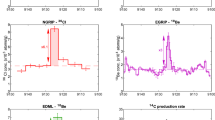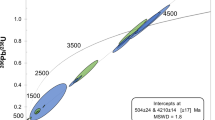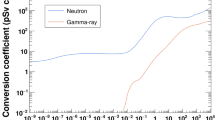Abstract
Polar glaciers contain a detailed historical record of artificial radioactive fallout from the atmosphere1–4. The records are continuous and time frames can be introduced with uncertainties of about ±1 yr. We have previously indicated that there may be characteristic nuclide compositions of fallout produced by weapons testing by different countries from records in ice sheets. For example, the testing period dominated by the US activity in the early 1950s produced a markedly low 238Pu/239+240Pu ratio and a very high 241Pu/239+240Pu ratio compared with those resulting from tests dominated the USSR activity in the early 1960s1,3,5. Here we use analyses on a recently collected Greenland ice sheet core to extend these results and find the characteristic 239+240Pu/137Cs and 239+240Pu/90Sr ratios for these two periods. The atmospheric behaviours of tritium compared with those of other artificial radionuclides are recorded in its fluxes to the polar ice sheets.
This is a preview of subscription content, access via your institution
Access options
Subscribe to this journal
Receive 51 print issues and online access
$199.00 per year
only $3.90 per issue
Buy this article
- Purchase on Springer Link
- Instant access to full article PDF
Prices may be subject to local taxes which are calculated during checkout
Similar content being viewed by others
References
Koide, M., Michel, R., Goldberg, E. D., Herron, M. M. & Langway, C. C. Earth planet. Sci. Lett. 44, 205 (1979).
Koide, M., Goldberg, E. D., Herron, M. M. & Langway, C. C. Nature 269, 137 (1977).
Cutter, G. A., Bruland, K. W. & Risebrough, R. W. Nature 279, 628 (1979).
Jouzel, J., Pourchet, M., Lorius, C. & Merlivat, M. Earth planet. Sci. Lett. 45, 188 (1979).
Koide, M. & Goldberg, E. D. Earth planet. Sci. Lett. 54, 239 (1981).
Goldberg, E. D. in Radioactive Dating 121–131 (IAEA, Vienna, 1963).
Reeh, N. et al. J. Glacial. 20, 27 (1978).
Carter, W. & Moghissi, A. A. Hlth Phys. 33, 55 (1977).
Lambert, G., Ardovin, B. & Brichet, E. Earth planet. Sci. Lett. 11, 317 (1971).
Perkins, R. W. & Thomas, C. W. in Transuranic Elements in the Environment (ed. Hanson, W. C.) 53 (Technical Information Center, US Department of Energy, 1980).
Ericksson, E. Tellus 15, 303 (1965).
Burton, J. D. in Chemical Oceanography Vol. 3, Chap. 18 (Academic, New York, 1975).
Herron, M., Herron, S. L. & Langway, C. C. Nature 293, 389 (1981).
Author information
Authors and Affiliations
Rights and permissions
About this article
Cite this article
Koide, M., Michel, R., Goldberg, E. et al. Characterization of radioactive fallout from pre- and post-moratorium tests to polar ice caps. Nature 296, 544–547 (1982). https://doi.org/10.1038/296544a0
Received:
Accepted:
Published:
Issue Date:
DOI: https://doi.org/10.1038/296544a0
This article is cited by
-
Water Circulation and Marine Environment in the Antarctic Traced by Speciation of 129I and 127I
Scientific Reports (2017)
-
Anthropogenic radionuclides in atmospheric air over Switzerland during the last few decades
Nature Communications (2014)
-
Determination of Pu, Am, U and Cs in large soil samples in the vicinity of the USDOE Waste Isolation Pilot Plant
Journal of Radioanalytical and Nuclear Chemistry (2011)
-
Radionuclides as tracers of water fronts in the South Indian Ocean—ANTARES IV Results
Journal of Oceanography (2009)
-
Plutonium,241Am,90sr, and137cs concentrations in some antarctic matrices
Biological Trace Element Research (1999)
Comments
By submitting a comment you agree to abide by our Terms and Community Guidelines. If you find something abusive or that does not comply with our terms or guidelines please flag it as inappropriate.



